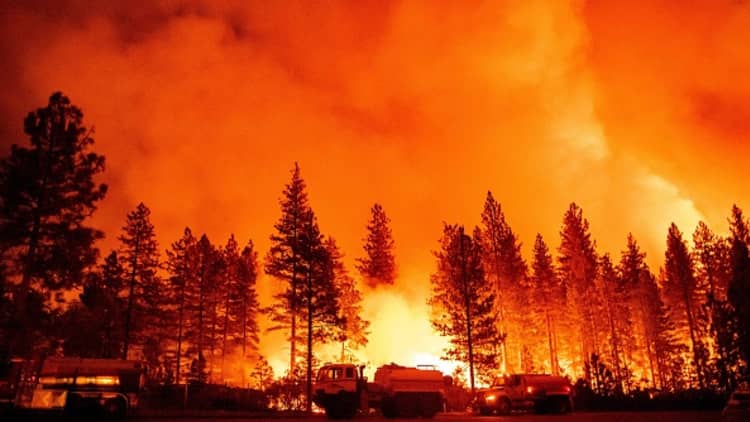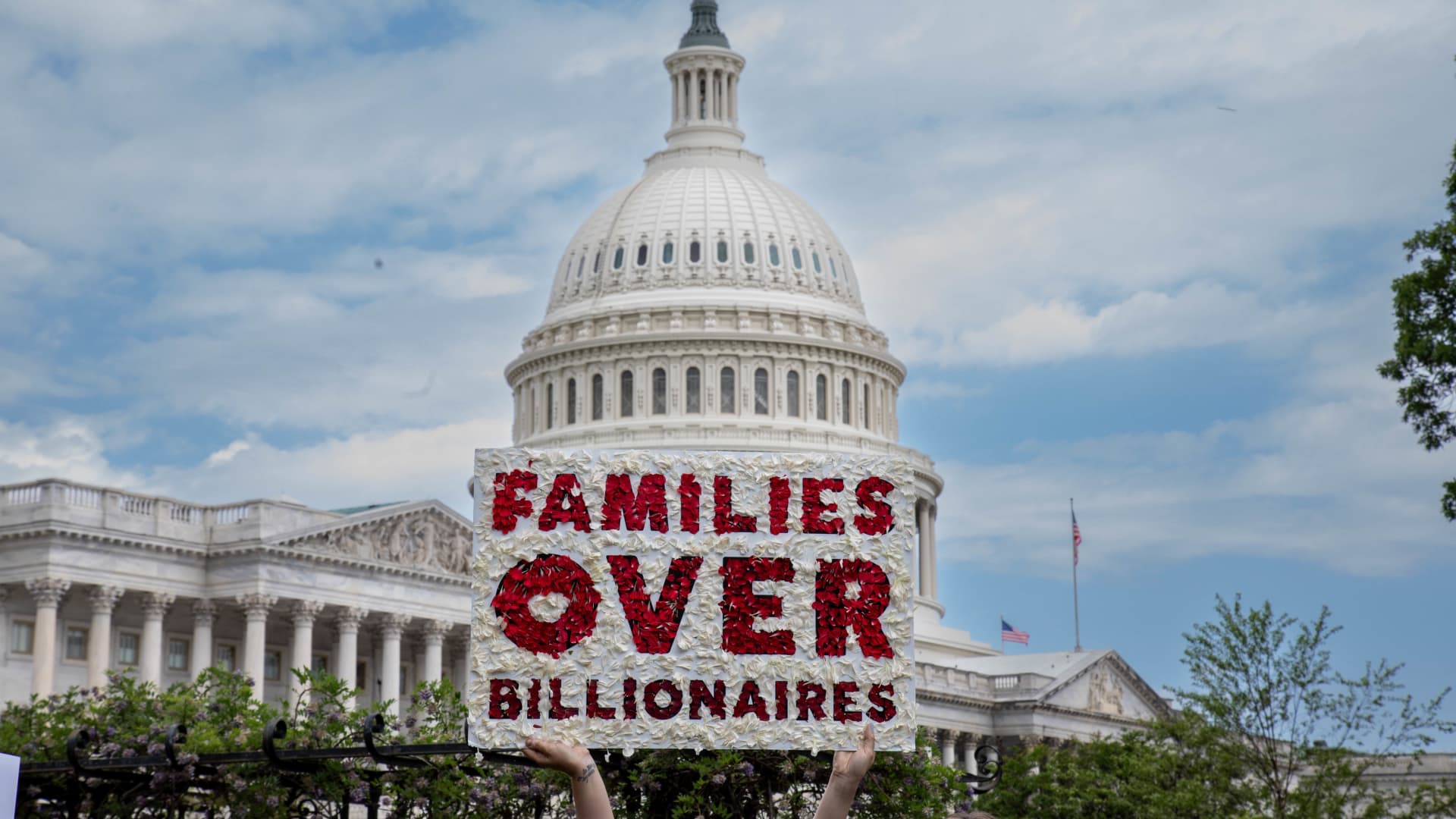Burned trees from the Palisades Fire and dust blown by winds are seen from Will Rogers State Park, with the City of Los Angeles in the background, in the Pacific Palisades neighborhood on Jan. 15, 2025 in Los Angeles, California.
Apu Gomes | Getty Images
Insurance premiums were surging well before this year’s massive wildfires in the Los Angeles area.
Now, they are set to rise even higher as the L.A. wildfires could become the costliest blaze in U.S. history, analysts say.
The insured losses may cost more than $20 billion, according to estimates by JPMorgan and Wells Fargo.
More from Personal Finance:
Wildfire victims may qualify for one-time $770 payment
Steps homeowners and renters should take after a wildfire
Top-rated charities active in the wildfire relief effort
For California residents, the increased frequency and severity of natural disasters has had a direct impact on homeowners insurance costs, a trend that is now even more likely to accelerate.
“In the short term, insurance regulators need to allow for risk-based pricing,” Patrick Douville, vice president of global insurance and pension ratings at Morningstar, said in a statement. “This means that premiums are likely to increase, and affordability issues will continue, potentially affecting property values and leaving some homeowners without insurance.”
California’s Department of Insurance also recently passed regulations that pave the way for rate increases in exchange for increased coverage in wildfire-prone regions. In 2024, some insurance companies in the state hiked rates as much as 34%, according to the San Francisco Chronicle.
While it’s too early to predict how the fires in Southern California will directly impact the bottom line, filing one fire claim can increase premiums by 29%, on average, and two claims could boost premiums by 60%, according to a 2024 analysis by Insure.com.
Going forward, premiums are almost guaranteed to go up as insurers attempt to cover their costs, according to Janet Ruiz, a director at the Insurance Information Institute and the organization’s California representative.
“We have to take in enough money in premiums to pay out the claims,” she said.
But even for homeowners outside of California, worsening extreme weather means higher insurance rates are on the way.
How disasters affect can costs in other states
The rest of the nation also wants to know: Will my insurance premiums be increasing? According to Ruiz, the short answer is no.
“Homeowners and business owners in one state do not pay insurance premiums based on losses or catastrophes in other states,” she said.
Because each state has a department of insurance that regulates rates in that region, there are protections in place to prevent that from happening, Ruiz said.
And yet, even though insurance premiums are subject to extensive regulations at the state level, when insurers cannot adjust rates in highly regulated states, they do compensate by raising rates in less-regulated states — despite protections in place — leading to “a growing disconnect between insurance rates and risk,” according to a 2021 paper by economists at Harvard Business School, Columbia Business School and Federal Reserve Board.
“Our findings call into question the sustainability of the current regulatory system, especially if natural disasters become more frequent or severe,” the authors wrote.
“Many insurance companies operate nationwide, or at least in multiple states,” said Holden Lewis, mortgage and real estate expert at NerdWallet.
“They are going to make up for their losses somewhere,” Lewis said.
In the wake of the wildfires, Michael Barrett, co-principal at Barrett Insurance Agency in St Johnsbury Vermont, where state insurance regulations are looser, said he has fielded lots of calls from clients asking about whether their premium will rise — “and the real true answer is it could,” he said.
“From an insurance perspective, an increase in natural disasters will impact insurance going forward,” Barrett said.
Vermont is not immune from its own extreme weather lately.
“We had incredible rains with severe flooding,” Barrett said. “It’s something that’s very concerning as we see the reliance on insurance elevated through these events.”
Extreme weather is a problem nationwide
What has happened in California underscores what could happen in other parts of the country as well, partly due to increased climate concerns.
Last year, 27 different natural disasters, from wildfires to winter storms, cost $1 billion each, the National Oceanic and Atmospheric Administration found.
Nearly half of all homes in the U.S. are now at risk of severe or extreme damage from environmental threats, according to a separate Realtor.com report.
Annual premiums are heading higher
In part because of escalating weather-related risks, home insurance rates jumped 33.8% between 2018 and 2023, rising 11.3% in 2023 alone, according to S&P Global Market Intelligence.
A working paper published by the National Bureau of Economic Research found an even sharper 33% increase in average premiums just between 2020 and 2023 and that climate-exposed households will face $700 higher annual premiums by 2053.
The national average cost of home insurance is now $2,181 a year, on average, for a policy with a $300,000 dwelling limit, or about $182 per month, according to Bankrate.
What each homeowner pays depends on the home as well as the city, state and proximity to areas prone to floods, earthquakes or wildfires, among other factors, experts say.
But generally, all of those factors have caused costs to go up across the board, including the impact of extreme weather and the rising costs of repairing or rebuilding.
Rising repair costs also play a role
Especially since the pandemic, the cost of rebuilding has risen significantly and continues to increase.
“That same home that might have cost $166 a square foot to rebuild now costs easily $300, and that’s if you are not doing a lot of frills,” Barrett said.
“When people renew their insurance policies, they might just renew the same maximum payout,” said NerdWallet’s Lewis. “A lot of homeowners are not even thinking about that.”
But because repairing damaged homes has become much more expensive, that can cause homeowners to be underinsured, leaving them vulnerable to substantial losses.
Homeowners are likely underinsured
Lewis advises homeowners to get an updated estimate on how much would it cost to rebuild if the home was destroyed in a fire or other natural disaster by asking an insurance agent or local contractor.
“You want to be insured for that amount,” he explained.
You also want to have the right kinds of coverage.
For example, a recent report by the Consumer Financial Protection Bureau found that hundreds of thousands of homeowners are likely underinsured against the risk of flooding. Since homeowners and renters insurance policies don’t cover flood damage, that requires a separate flood insurance policy.
According to the consumer watchdog, the flood risk exposure of the mortgage market “is more extensive and more geographically dispersed than previously understood.”
Homeowners near inland streams and rivers, specifically, were less likely to have flood insurance or other financial resources to draw on to recover from a flood and “are most at risk of suffering catastrophic loss.” The report was based on a sample of mortgage applications from 2018-2022.
“I encourage people every year, when you get your renewal notice, look at that rebuilding amount and ask a contractor the average cost per square foot to rebuild,” Ruiz said. “People didn’t to pay much attention to their insurance but it’s important to understand if you need more or less — most people need more.”
Subscribe to CNBC on YouTube.


 Economics1 week ago
Economics1 week ago
 Economics1 week ago
Economics1 week ago
 Economics6 days ago
Economics6 days ago
 Finance1 week ago
Finance1 week ago
 Economics1 week ago
Economics1 week ago
 Blog Post7 days ago
Blog Post7 days ago
 Personal Finance6 days ago
Personal Finance6 days ago
 Economics1 week ago
Economics1 week ago
















